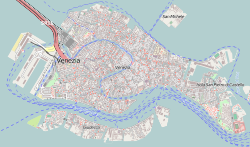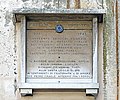Spanish Synagogue (Venice)
| Spanish Synagogue | |
|---|---|
 The synagogue façade, from the square of the Ghetto Nuovo, in 2015 | |
| Religion | |
| Affiliation | Orthodox Judaism |
| Rite | |
| Ecclesiastical or organisational status | Synagogue |
| Status | Active |
| Location | |
| Location | Jewish Ghetto, Venice |
| Country | Italy |
Location of the synagogue in Venice | |
| Geographic coordinates | 45°26′41″N 12°19′32″E / 45.4448°N 12.3256°E |
| Architecture | |
| Architect(s) | Baldassare Longhena |
| Type | Synagogue architecture |
| Style | Baroque |
| Date established | 1555 (as a congregation) |
| Completed | 1580 |
| Materials | Stone |
| [1] | |
The Spanish Synagogue (Italian: Scola Ponentina; or Italian: Sinagoga Scuola Spagnola) is an Orthodox Jewish congregation and synagogue, that is located in the Jewish Ghetto of Venice, Italy. Designed by Baldassare Longhena in the Baroque style, the synagogue was completed in 1580, and it is one of five synagogues that were established in the ghetto.[2][3]
The synagogue is open for services from Passover until the end of the High Holiday season.
History
[edit]The Spanish Synagogue was founded by Jews expelled from the Iberian peninsula in the 1490s who reached Venice, usually via Amsterdam, Livorno or Ferrara, in the 1550s. The four-story yellow stone building was constructed in 1580 and was restored in 1635. It is a clandestine synagogue, which was tolerated on the condition that it be concealed within a building that gives no appearance being a house of worship form the exterior, although the interior is elaborately decorated.[4]
The synagogue's ornate interior contains three large chandeliers and a dozen smaller ones, as well as a huge sculpted wooden ceiling.
Gallery
[edit]-
View towards the ark
-
Gate on campo delle scole
-
Holocaust memorial
See also
[edit]References
[edit]- ^ "Scuola Grande Spagnola in Venice". Historic Synagogues of Europe. Foundation for Jewish Heritage and the Center for Jewish Art at the Hebrew University of Jerusalem. n.d. Retrieved August 19, 2024.
- ^ Davis, Robert C.; Ravid, Benjamin, eds. (2001). The Jews of Early Modern Venice. Baltimore–London: Johns Hopkins University Press. p. 43. ISBN 0-8018-6512-3.
- ^ Tigay, Alan M., ed. (1994). The Jewish Traveler: Hadassah Magazine's Guide to the World's Jewish Communities and Sights. Northvale, N.J.–Jerusalem: Jason Aronson. p. 542. ISBN 978-1-56821-078-0.
- ^ Kaplan, Benjamin J., Religious Conflict and the Practice of Toleration in Early Modern Europe, Cambridge, Mass.: Harvard University Press, 2007, Chapter 8, pp. 194. ff.
External links
[edit]- "The Spanish Synagogue". Kiddush in Venice. Archived from the original on June 20, 2009.
- 1580s establishments in the Republic of Venice
- 16th-century synagogues in Italy
- Baldassare Longhena buildings
- Baroque architecture in Italy
- Baroque synagogues in Italy
- Dutch-Jewish diaspora
- Jews and Judaism in Venice
- Orthodox synagogues in Italy
- Portuguese-Jewish diaspora in Europe
- Sephardi Jewish culture in Italy
- Sephardi synagogues
- Spanish-Jewish diaspora in Europe
- Synagogues completed in 1580
- Synagogues in Venice
- European synagogue stubs
- Italian religious building and structure stubs




